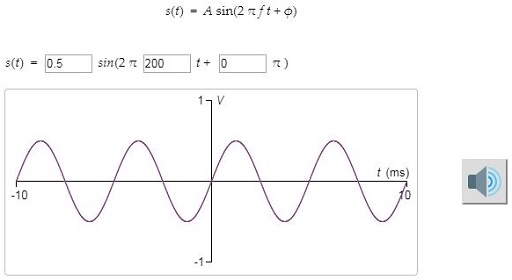4.4 Signals and sine waves
Interactive 2 shows a signal based on a sine wave, sin(2πft), where f is the frequency of the wave and t is time. Here the frequency of the wave is f = 200 Hz. The period of the wave, T, is the time between successive peaks; in this case, T = 5 ms (milliseconds). As would be expected, T = 1/f = 1/200 = 0.005 s. Similarly, f = 1/T = 1/0.005 = 200 Hz.
The signal is written as
s(t) = A sin(2πft + ϕ)
where A is called the amplitude of the wave, i.e. the largest value of the wave above or below the horizontal axis. Here it is set to A = 0.5.
ϕ is the phase of the wave, which means how far the wave is shifted to the left or the right. Here it is set to 0, since the wave goes through the origin and is not shifted either left or right.
Right-click on the image below to open the interactive in a new tab, then press the loudspeaker button to hear what the signal sounds like.
SAQ 7
- a.Change A to 1.0 and play the sound. What do you observe?
- b.Change f to 400 and play the sound. What do you observe?
- c.Change ϕ to π/2 and play the sound. (You can enter a phase of π/2 into the interactive as 90 degrees.) What do you observe?
Answer
- a.The wave is displayed with twice the height and the sound is louder.
- b.The wave is displayed with the lines much closer vertically, and the sound is at a higher pitch (it is an octave higher than before).
- c.The wave is moved along by a quarter of its period. Now it has the highest value at t = 0, where previously it was 0 at t = 0. However, it sounds the same.

